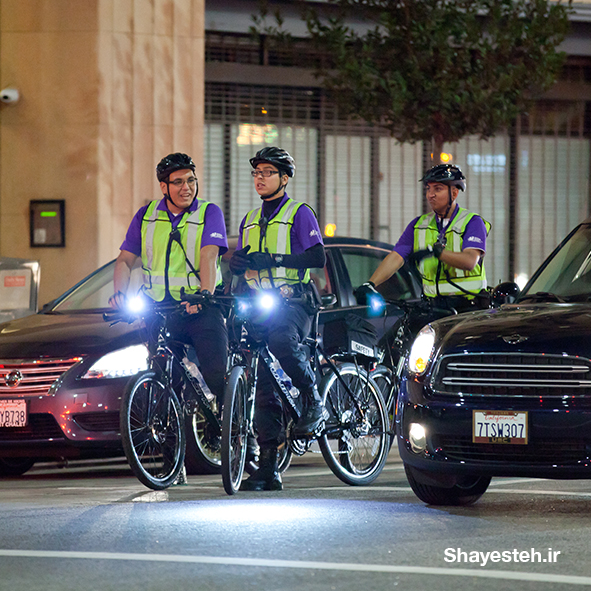در صورتی که اشکالی در ترجمه می بینید می توانید از طریق شماره زیر در واتساپ نظرات خود را برای ما بفرستید
09331464034
Topic:
The following appeared in a recommendation from the President of the Amburg Chamber of Commerce.
"Last October, the city of Belleville installed high-intensity lighting in its central business district, and vandalism there declined almost immediately. The city of Amburg, on the other hand, recently instituted police patrols on bicycles in its business district. However, the rate of vandalism here remains constant. Since high-intensity lighting is clearly the most effective way to combat crime, we recommend using the money that is currently being spent on bicycle patrols to install such lighting throughout Amburg. If we install this high-intensity lighting, we will significantly reduce crime rates in Amburg."
Write a response in which you discuss what questions would need to be answered in order to decide whether the recommendation is likely to have the predicted result. Be sure to explain how the answers to these questions would help to evaluate the recommendation.
موارد زیر در توصیه رئیس اتاق بازرگانی آمبورگ آمده است.
"اکتبر گذشته، شهر بویلویل نورپردازی با شدت بالا را در منطقه تجاری مرکزی خود نصب کرد، و خرابکاری در آنجا تقریبا بلافاصله کاهش یافت. از طرف دیگر، شهر آمبورگ، اخیراً گشت های پلیس را با دوچرخه در منطقه تجاری خود ایجاد کرد. با این حال، میزان خرابکاری در اینجا ثابت است. از آنجا که روشنایی با شدت بالا به طور واضح موثرترین راه برای مبارزه با جرم است، ما توصیه می کنیم با استفاده از هزینه ای که در حال حاضر برای گشت های دوچرخه صرف می شود چنین روشنایی را در سراسر آمبورگ نصب کنید. اگر این نورپردازی با شدت بالا را نصب کنیم، به میزان قابل توجهی میزان جرم و جنایت را در آمبورگ کاهش خواهیم داد. "
پاسخی بنویسید که در آن درباره اینکه چه سوالاتی باید پاسخ داده شود تا تصمیم بگیرید که آیا توصیه پیشنهادی می تواند نتیجه پیش بینی شده را ایجاد کند. حتماً توضیح دهید که چگونه پاسخ این سوالات به ارزیابی پیش بینی کمک می کند.
NOTE: The above topic has wording similar to Argument Task 163 of this Website. However, if you read carefully you will notice that the topic and the task instructions are different. Hence, it is very important to read the topic as well as its instructions completely before you start to write your response.
Strategies
The first step in performing your analysis consists of identifying the texts’ key point, recommendation, prediction or hypothesis. All the other arguments and assumptions are designed to support this central claim. In this case, the author attempts to demonstrate that “If we install this high-intensity lighting, we will significantly reduce crime rates in Amburg”.
The next step would involve creating a statement that summarizes the text by including the central claim and its supporting arguments.
Based on the crime prevention success of high intensity lighting in the city of Belleville and the unchanged vandalism rates following the measures implemented in Amburg, the president of the Amburg Chamber of Commerce recommends to redirect funds from bicycle police patrols to high intensity lighting in a bid to significantly reduce the crime rates of the town.
When considering what questions are needed to evaluate the arguments outlined in the text, it is important to keep in mind that arguments are based on assumptions – points that are taken to be true, without need for proof. This is what you need to look for – explicit and implicit assumptions, since they lack the evidence required to prove their validity.
Assumptions:
i) Explicit Assumption: The measures applied in Belleville will have the same results in Amburg.
Implicit Assumptions:
a) Vandalism makes up most of the crime rate in Amburg.
b) The two cities’ demographics are similar.
c) Belleville and Amburg face the same type of criminal problems.
ii) Explicit Assumption: High intensity lighting is more effective than police patrols.
Implicit Assumptions:
a) Police bicycle patrols have been implemented for a sufficient length of time to start showing results.
b) High intensity lighting is more effective than police patrols at stopping other types of crimes than just vandalism.
iii) Explicit Assumption: The high intensity light in Belleville had a significant impact on the crime rate.
Implicit Assumptions:
a) The crime rate in Belleville was high.
b) The crime rate was reduced throughout the city.
c) Vandalism constitutes the greatest percentage of crimes.
iv) Explicit Assumption: High light intensity is the only measure responsible for the reduction in vandalism in Belleville.
Implicit Assumptions:
a) There were no external causes (like economical health) that could have influenced the outcome.
b) There were no other crime prevention methods being deployed at the same time.
After having established your assumptions, you can find the evidence that is needed to evaluate the argument by considering what proof is necessary to validate each implicit assumption.
Questions:
a) What is the minimum time necessary for police bicycle patrols to start showing results?
b) How effective is high intensity lighting vs police patrols at stopping crimes other than vandalism?
c) What percentage of Amburg’s crime rate is constituted by vandalism?
d) How high was the crime rate in Belleville before the introduction of the high intensity lighting?
e) With the introduction of the high intensity lighting was the crime rate reduced also throughout the city?
f) Are there any other external causes such as economical health that could have influenced the outcome in Belleville?
g) Were there other crime prevention methods used at the same time as the high intensity lighting
h) How comparable are Amburg and Belleville’s demographics?
i) How similar are the types of criminal problems both cities have to face?
NOTE: The above topic has wording similar to Argument Task 163 of this Website. However, if you read carefully you will notice that the topic and the task instructions are different. Hence, it is very important to read the topic as well as its instructions completely before you start to write your response.
Sample 1:
Based on the crime prevention success of high intensity lighting in the city of Belleville and the unchanged vandalism rates following the measures implemented in Amburg, the president of the Amburg Chamber of Commerce recommends to redirect funds from bicycle police patrols to high intensity lighting in a bid to significantly reduce the crime rates of the town.
Since the measure proposed by the author of the argument is not meant to supplement but replace one form of protection with another, it becomes essential to have a proper evaluation of the effectiveness of both measures. This additional data can be obtained by answering a few basic questions about the assumptions made by the author.
One such question deals with the assumption that the introduction of high intensity lighting in Belleville had a significant impact on the town’s crime rate. Since the lighting was introduced mainly in the business center of the town, the first question that comes to mind is if the crime rate was also reduced throughout the city or only mainly in the area where the lighting was introduced. If the overall crime rates were lowered, that would make the high intensity lighting a very effective measure, provided that the results stay constant for a long period of time (and the criminals don’t figure out new ways around them). In this case, the argument made by the president of the Amburg Chamber of Commerce would be significantly strengthened, more so since the proposal argues for introducing this measure throughout the city. Should the crime rates stay the same in the parts of town not covered by high intensity lighting, that would not affect the argument of the author, since, as stated above, the plan is to introduce high intensity lighting throughout the city.
Another way of evaluating the success of the high intensity lighting in preventing crime in Belleville is to inquire just how high the crime rate was before the introduction of high intensity lighting and what constitutes a significant increase. Following that line of thought, if the crime rate before the introduction of the high intensity lighting was very low, then the results could be due to chance and not any real effectiveness on the part of the implemented measure. It is always the case when dealing with statistics of any kind – low numbers tend to come with a high standard deviation (meaning that, in small groups, each occurrence of an event holds greater weight). However, a high crime rate would strengthen the validity of the conclusions drawn from the Belleville example, provided that there were no other factors that could have influenced the results. In this case, the main argument would not be affected much, since it depends on a whole host of other, more significant assumptions.
When describing the effectiveness of the high intensity lighting in Belleville, the author of the argument draws attention to the reduction in the rates of vandalism occurring in the area where the measure was instated. There is not much data about the impact of high intensity lighting on other types of crimes. This begs the question of what percentage of Amburg’s crime rate is constituted by vandalism? If most of the crimes committed in the city of Amburg are related to forms of vandalism, then that fact would strengthen the proposal to introduce high intensity lighting in the city since the measure was shown to be particularly effective for this type of crime. However, should vandalism constitute only a small percentage of the types of crimes committed in the city of Amburg, that would significantly weaken the assumption that crime rates would be reduced by installing high intensity lighting, since it is entirely possible that the method is not effective against the other types of crimes.
When making his case for the introduction of high intensity lighting in the town, the president of the Amburg Chamber of Commerce assumes that this measure was the only one that was responsible for the reduction in vandalism in Belleville. Before launching a proposal that could have no effect on the town’s safety, the author should wonder if there were any other external causes that could have influenced the outcome in Belleville. It is entirely possible that at the time, the economical health of the region improved alongside the overall wellbeing of the citizens which triggered a reduction in petty crimes. Should there be any other reasons for the decrease in crimes, like the one mentioned above, then it becomes highly likely that introducing the high intensity lighting in Amburg will not have the desired effect. However, if there is no other external explanation for the drop in crime rates, then that would significantly strengthen the bid of the president of the Chamber of Comerce to add high intensity lighting, provided that there were also no other crime reduction methods in place at the time. If the town of Belleville had ran other crime prevention methods like police patrols in parallel with the high intensity lighting program then it would become questionable to introduce only one part of the equation in Amburg without considering the exact role that each measure had to play in reducing the crime rate. However, should the opposite be true, then high intensity lighting would have increased credibility as a crime reduction method and the author’s proposal to introduce it in Amburg would gain more merit.
The president of the Amburg Chamber of Commerce recommends to install high intensity lighting by diverting funds from the existing bicycle police patrols, based on the assumption that it would be more effective than the police patrols at reducing the crime rate. The author compares a fully-fledged program (the one in Belleville) with a newly instated one. The question in this case is what is the minimum time necessary for police bicycle patrols to start showing results reported to how long the measure was instated in Amburg before being evaluated. If the police bicycle patrols require much more time to be effective than the period that passed between their introduction and evaluation, then that fact would weaken the assumption that high intensity lighting is more effective than police patrols at reducing crime, simply because the data about the patrols is inaccurate. In this case, replacing the patrols with the high intensity lighting might be an unnecessary move. However, if the reverse is true and the results of introducing police bicycle patrols should be visible immediately, then the author of the argument would have been correct in assuming that high intensity lighting is the more effective measure, provided that the data from Belleville is accurate.
When making the suggestion to replace bicycle patrols with high intensity lighting, the president of the Amburg Chamber of Commerce assumes that the measures that were applied in Belleville will have the same results in Amburg. In order to be able to claim that with any degree of certainty, the author of the argument should inquire into just how comparable are the types of criminal problems the two cities have to face. Should both Amburg and Belleville have very similar types of crimes they face, that bit of information would strengthen the argument that the measures applied in Belleville can be expected to have the same results in Amburg. The main claim that introducing high intensity lighting will significantly reduce crime rates would only be slightly strengthened, since it depends more on whether or not the measure is actually effective. Should the cities face completely different types of crimes then it would not do well to assume that the same crime fighting measure would be effective in both cities. For instance, if Belleville mainly has to deal with vandalism, while Amburg is rife with organized crime, then installing high intensity lighting on the streets would have no effect on the high level crimes being committed in Amburg, especially since a lot of these types of crimes are committed in broad daylight, when high intensity lighting is superfluous.
All in all, the president of the Chamber of Commerce of Amburg should take more time to investigate the effectiveness of both high intensity lighting and police bicycle patrols before suggesting to replace one measure with the other. Without the proper information, the author of the argument might suggest a course of action that could prove to be ineffective and/or costly.
نظرات کاربران
هنوز نظری درج نشده است!


